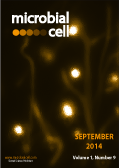Metabolic pathways further increase the complexity of cell size control in budding yeast
Jorrit M. Enserink
News and thoughts |
page 276-278 | 10.15698/mic2014.09.167 | Full text | PDF |
Cell wall dynamics modulate acetic acid-induced apoptotic cell death of Saccharomyces cerevisiae
António Rego, Ana Marta Duarte, Flávio Azevedo, Maria João Sousa, Manuela Côrte-Real and Susana R. Chaves
Research Articles |
page 303-314 | 10.15698/mic2014.09.164 | Full text | PDF |
Abstract
Acetic acid triggers apoptotic cell death in Saccharomyces cerevisiae, similar to mammalian apoptosis. To uncover novel regulators of this process, we analyzed whether impairing MAPK signaling affected acetic acid-induced apoptosis and found the mating-pheromone response and, especially, the cell wall integrity pathways were the major mediators, especially the latter, which we characterized further. Screening downstream effectors of this pathway, namely targets of the transcription factor Rlm1p, highlighted decreased cell wall remodeling as particularly important for acetic acid resistance. Modulation of cell surface dynamics therefore emerges as a powerful strategy to increase acetic acid resistance, with potential application in industrial fermentations using yeast, and in biomedicine to exploit the higher sensitivity of colorectal carcinoma cells to apoptosis induced by acetate produced by intestinal propionibacteria.
Extracellular calcium triggers unique transcriptional programs and modulates staurosporine-induced cell death in Neurospora crassa
A. Pedro Gonçalves, João Monteiro, Chiara Lucchi, David J. Kowbel, J. Miguel Cordeiro, Paulo Correia-de-Sá, Daniel J. Rigden, N. Louise Glass, Arnaldo Videira
Research Articles |
page 289-302 | 10.15698/mic2014.09.165 | Full text | PDF |
Abstract
Alterations in the intracellular levels of calcium are a common response to cell death stimuli in animals and fungi and, particularly, in the Neurospora crassa response to staurosporine. We highlight the importance of the extracellular availability of Ca2+ for this response. Limitation of the ion in the culture medium further sensitizes cells to the drug and results in increased accumulation of reactive oxygen species (ROS). Conversely, an approximately 30-fold excess of external Ca2+ leads to increased drug tolerance and lower ROS generation. In line with this, distinct staurosporine-induced cytosolic Ca2+ signaling profiles were observed in the absence or presence of excessive external Ca2+. High-throughput RNA sequencing revealed that different concentrations of extracellular Ca2+ define distinct transcriptional programs. Our transcriptional profiling also pointed to two putative novel Ca2+-binding proteins, encoded by the NCU08524 and NCU06607 genes, and provides a reference dataset for future investigations on the role of Ca2+ in fungal biology.
Time resolved DNA occupancy dynamics during the respiratory oscillation uncover a global reset point in the yeast growth program
Cornelia Amariei, Rainer Machné, Viktor Stolc, Tomoyoshi Soga, Masaru Tomita, Douglas B. Murray
Research Articles |
page 279-288 | 10.15698/mic2014.09.166 | Full text | PDF |
Abstract
The structural dynamics of chromatin have been implicated in the regulation of fundamental eukaryotic processes, such as DNA transcription, replication and repair. Although previous studies have revealed that the chromatin landscape, nucleosome remodeling and histone modification events are intimately tied into cellular energetics and redox state, few studies undertake defined time-resolved measurements of these state variables. Here, we use metabolically synchronous, continuously-grown yeast cultures to measure DNA occupancy and track global patterns with respect to the metabolic state of the culture. Combined with transcriptome analyses and ChIP-qPCR experiments, these paint an intriguing picture where genome-wide nucleosome focusing occurs during the recovery of energy charge, followed by clearance of the promoter regions and global transcriptional slow-down, thus indicating a nucleosome-mediated “reset point” for the cycle. The reset begins at the end of the catabolic and stress-response transcriptional programs and ends prior to the start of the anabolic and cell-growth transcriptional program, and the histones on genes from both the catabolic and anabolic superclusters are deacetylated.
Combinatorial stress responses: direct coupling of two major stress responses in Escherichia coli
Daniel R. Brown, Geraint Barton, Zhensheng Pan, Martin Buck, Sivaramesh Wigneshweraraj
Microreviews |
page 315-317 | 10.15698/mic2014.09.168 | Full text | PDF |
Abstract
Nitrogen is an essential element for all life, and this is no different for the bacterial cell. Numerous cellular macromolecules contain nitrogen, including proteins, nucleic acids and cell wall components. In Escherichia coli and related bacteria, the nitrogen stress (Ntr) response allows cells to rapidly sense and adapt to nitrogen limitation by scavenging for alternative nitrogen sources through the transcriptional activation of transport systems and catabolic and biosynthetic operons by the global transcriptional regulator NtrC. Nitrogen-starved bacterial cells also synthesize the (p)ppGpp effector molecules of a second global bacterial stress response – the stringent response. Recently, we showed that the transcription of relA, the gene which encodes the major (p)ppGpp synthetase in E. coli, is activated by NtrC during nitrogen starvation. Our results revealed that in E. coli and related bacteria, NtrC functions in combinatorial stress and serves to couple two major stress responses, the Ntr response and stringent response.










